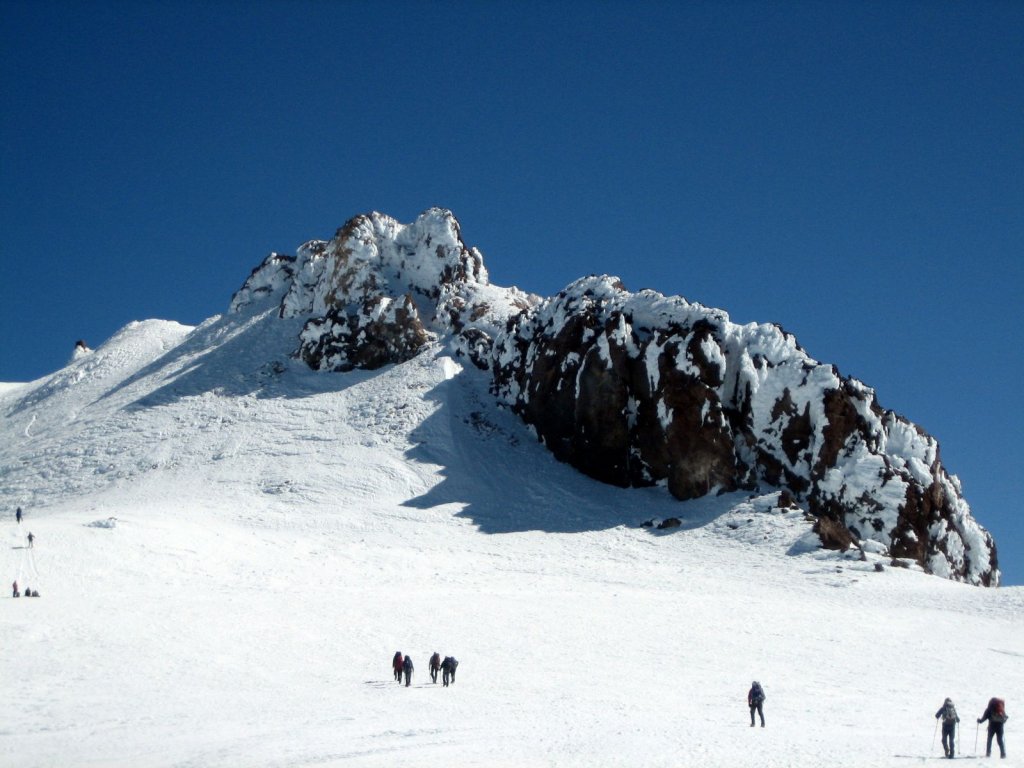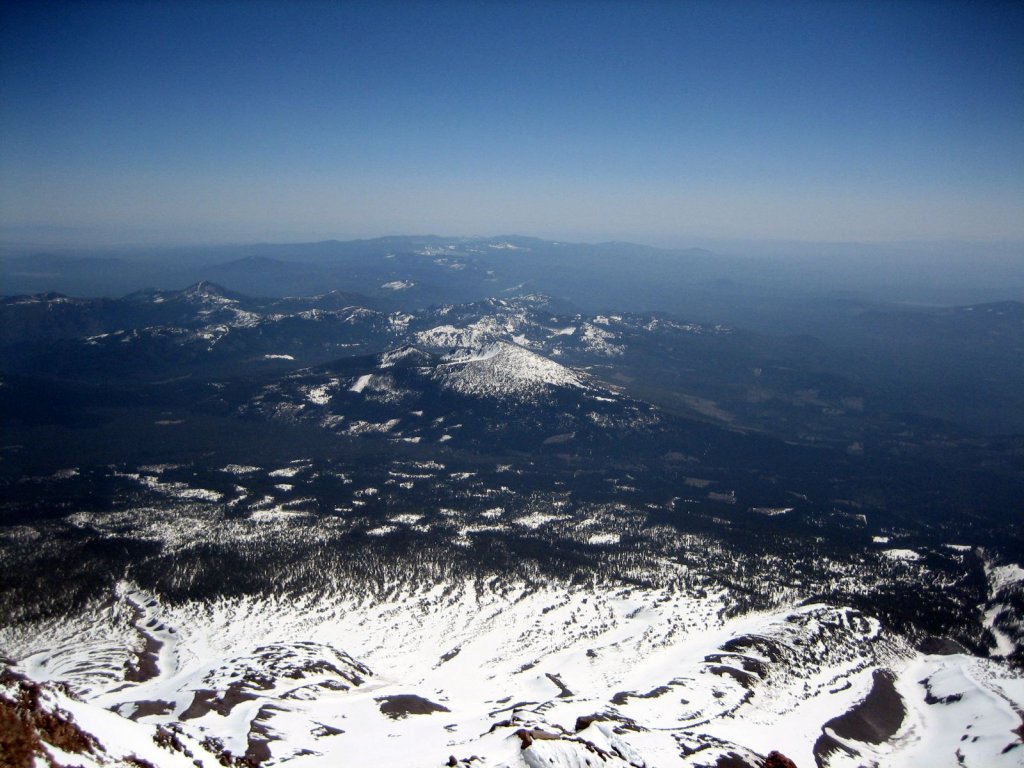
Mt. Shasta
I climbed Mt. Shasta expedition style from May 15-17th 2009 with Shasta Mountain Guides. Mt. Shasta is a volcano in the Cascades range in California, USA and stands at 14,179 ft. The Bunny Flat trail head is at 6950 ft. From there we backpacked to Horse Camp the first day about 2.1 miles to 8000 ft. The second day we climbed to base camp just below Lake Helen to about 10000 ft in about 2 miles. The third day we left base camp at 3:20 am and reached the summit at about 10:15 am. This is the steepest part of the climb gaining about 4000 ft in about 2 miles. We then descended back to base camp, broke camp and got back to the trail head at about 4:00 pm.
My published article in India Currents

Horse Camp (8000 ft)
I drove up one Thursday to the town of Mount Shasta, California and the next day joined our two guides and seven other climbers at The Fifth Season shop to rent all the mountaineering gear: ice axe, crampons, mountaineering boots, and helmet, all of which were new to me. We also had a complete checklist of items needed for the three day expedition. I was alarmed after packing my backpack; it was so heavy that I needed help in lifting it and hoisting it onto my back.
We drove to the Bunny Flat trailhead at 6,950 feet and headed off towards Horse Camp at 8,000 feet. Each step was an adventure. I did not know if my feet would sink into soft mushy melting snow or strike a hard, slippery, icy surface. I began to observe how distracted my mind usually was, because each time my focus wavered, I went scrambling. Slowly I began to let go of my thoughts and just focus on my steps. Within a couple of hours we reached Horse Camp.

Snow Camping
To setup a campsite in the snow, first we shoveled out a flat spot to pitch our tent. After the tent was pitched, we attached the guy lines to a stick/rock and buried it in the snow. During the night when the snow hardens, this will prevent the tent from blowing off in the wind. Then we dug a trench in the vestibule area so we could comfortably sit in the tent and dangle our feet into the vestibule area to put on our shoes. We then built a kitchen: an area to stand and cook, a counter top, and a bench (lined with sleeping pads) to sit and eat.
After setting up camp, we headed up a hill for Snow School. Here we learned how to walk up by kicking in a staircase, how to hold and use the Ice axe and some self arrest techniques if we were to fall. We were told to yell “rock” if we saw something fall, and "falling" if we were the ones falling.
After snow school, we had a delicious dinner with hot corn chowder soup and crackers, and burritos with rice, beans, fresh guacamole and salsa. We practiced “Leave no trace” to an extreme.
We were advised to take off the inner soft layer of the double plastic boots and stuff it into the sleeping bag near the feet to help dry it. We were also to put our wet socks and liner gloves between layers of clothes on our chest to dry them out.
I stepped out once at night for a toilet break and was rewarded with a stunning night sky and the soft glow of the snow in the star light.

Avalanche Gulch
We packed up by 9 a.m. the next day and began a steady climb towards Lake Helen. We had to climb 2,000 feet in two miles with a backpack that seemed to be gaining weight. We kicked our feet into the snow with each step up to carve out a bootpack staircase. As we were crossing Avalanche Gulch, the guides pointed out signs of recent avalanches. We were now above the tree line and there was nothing but a steady slope of snow stretched out ahead. We took breaks every hour and made it up to base camp at 10,000 feet, slightly below Helen Lake.

Base Camp (10000 ft)
Some among us were already feeling the effects of the altitude—headaches and loss of appetite. One in our party decided to stay back and abandon the summit attempt. I felt like our tent was floating on a frothy wave. It looked precarious on the snowy slope with no protection from the wicked winds that could whip us at night. The guides went through the routine and taught us more techniques like rope travel and glissading (sliding down the slope sitting down.) We had dinner of hot pasta and prepared for the early morning Summit climb.
We stripped down the backpack to the bare essentials of warm jacket, food and water and readied all the equipment like helmet with head lamps, harness for the rope traverse, thin inner layer, warm mid layer and outer waterproof layers of clothing, gloves etc., and hit the sleeping bag before 8 p.m.

Summit Attempt
We were woken up at 1:30 a.m. by the guides asking us to begin preparing for the ascent. It was 3:20 a.m.before we had all eaten, dressed, geared up and ready to make our way up in the dark. I was on the rope team with one of the guides and two other climbers. It was a pleasant morning and I felt cheerful and full of high spirits as we made our way up towards Helen Lake and from there onto Red Banks. Red Banks is a band of red rocks at the top of the steepest part of the climb. We gain over 2,000 feet in about a mile taking us up to 12,600 feet. The beginning of the climb felt easy due to the firm bootpack created by climbers ahead of us. I looked up to see a starry staircase created by the headlamps of climbers ahead of us rising up to meet the billions of stars illuminating the night sky.
About an hour into the climb, we stopped on the steep slopes and attached crampons to our boots. The sharp teeth of the crampons held onto the now icy surface with a firm bite. It was a slow steady climb—one foot up, next foot up, ice axe up, power breath to force air into the lungs and so on.

Dawn
About half way up, dawn broke and there was lightness in the air. Everything was illuminated with a pinkish glow. Unfortunately I could also now see the top of the Red Banks which seemed impossibly far, but it also seemed like we had come a long way up. The thing with Mt. Shasta is that there is nothing obstructing your view up or down for thousands of feet, which can be intimidating.
After reaching the Red Banks I was disheartened to realize we had more steep climbs ahead of us. The sun was now out, the layers were making me feel hot and stuffy, the light was blinding even with the sunglasses, and the snow reflected UV radiation in all directions. I was beginning to worry that my slow pace might jeopardize the summit for others on my rope team. But thoughts, good and bad, need to be squelched in a hurry in such an environment. Each step and each breath demand complete attention.

Summit Plateau
Up Short Hill and up Misery Hill we went till finally we reached the Summit Plateau. Ahead was the Summit Pinnacle glowing like a red ruby rising up from the glistening, moving sea of snow and ice. The smoke rising from the sulfur springs reminded me that the mountain is very much alive.

Summit
With each belabored and conscious step, I connected with the spirit of the mountain. The guide pointed at the final red rock scramble and said that there were 30 to 40 more steps to the summit. I had tears of gratitude in my eyes for the mountain and the guide and everyone who had helped me get this far. The views were clear and spectacular in every direction. The conditions could not have been more perfect. I had more tears when I realized how much the forces of nature must have colluded to make it so perfect.

The rest of the Journey
By the time we were heading down, the snow was softening. We took off our crampons at the top of the Red Banks as it is safer to walk without them on softer snow. The plan was to glissade down from the Red Banks. It is unsafe to stay on that stretch in the afternoon as the risk of rock fall increases significantly. Everyone else had gone ahead and I was the last one to go.
Since I am not a skier, the prospect of long steep icy downhill rides on my behind was fairly intimidating to me, while it is great fun for those experienced in the sport. I gingerly put my feet on either side of the glissade chute (formed by those who had glissaded earlier), sat down, prepared my ice axe as a break and took off down towards Helen Lake over 2,000 feet below. Within seconds I felt I was accelerating too rapidly and used the ice axe to self arrest and stop. This was very unnerving and I was shaken. There was no way out now, so I got back into the chute and started off again. Again, I felt very out of control as the speed was too much. As I was on my belly sliding down rapidly trying to use the ice axe to help me stop, I got bumped in my knee and was thrown around. I lost the axe, was now on my back, head pointing down, sliding at top speed down 2,000 feet of icy slope, completely helpless. In sheer terror, I called for help.
The next thing I knew, I had bumped into the guide. She was rock solid, calm, gentle, and in that moment—God. When I got bumped I could have been thrown in any direction, but the mountain that had made me visit her, made sure I was safe. After this harrowing experience, the guide managed to retrieve my ice axe, rope me to her, and helped me get back to base camp safely.
My knee was pretty inflamed, if not broken. God showed up again and this time in the form of my tent mate, who happened to be an ER doctor. I was quickly examined and given a strong anti-inflammatory drug. I had to still make it down four miles with my 35 lb backpack. With each step, slip, and slide towards the car I felt a peace and strength within. For the first time, without any doubt I knew I was not alone—ever. There was a larger purpose to everything.
